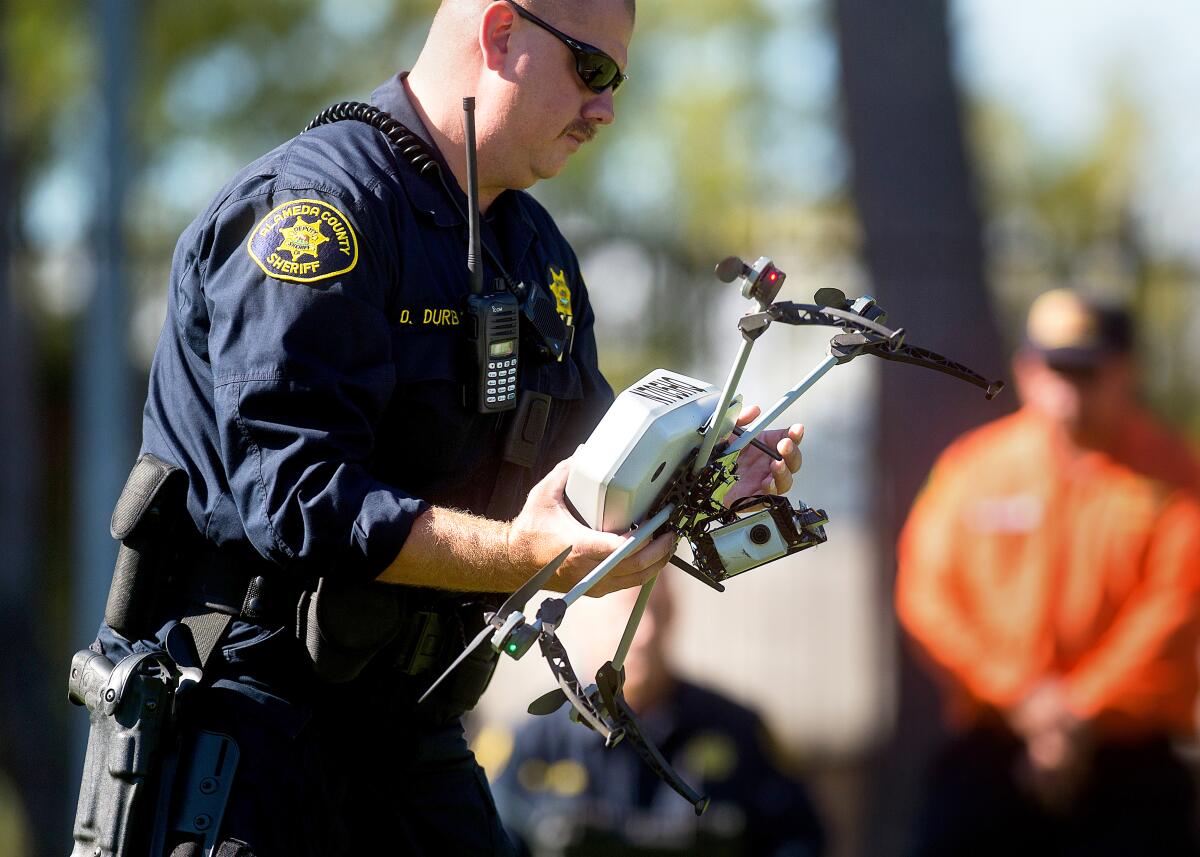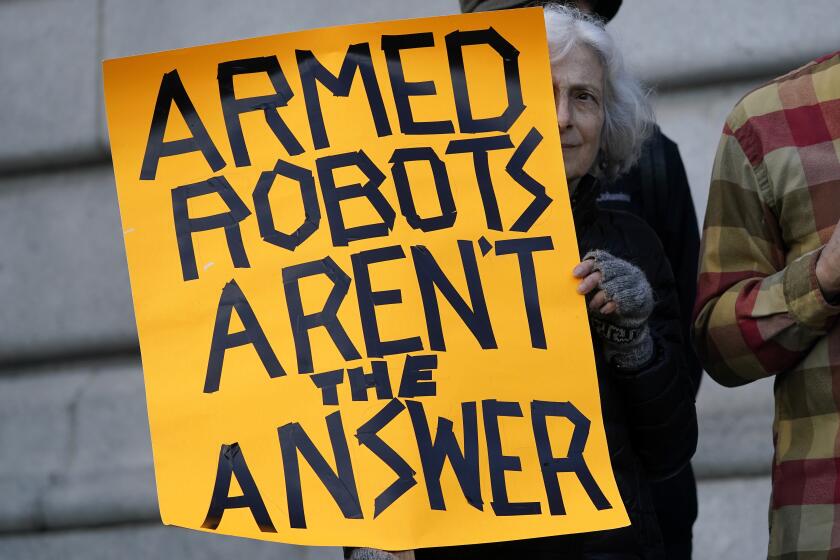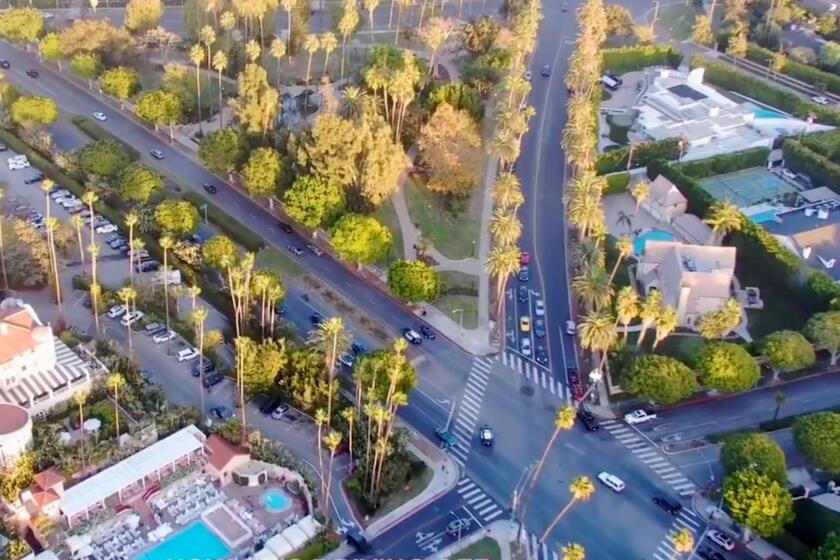Police drones could soon crisscross the skies. Cities need to be ready, ACLU warns

- Share via
The use of police drones is “poised to explode” in the next year as law enforcement takes advantage of the technology’s proliferation, leaving public regulation and transparency efforts in danger of being caught woefully behind, civil rights advocates warn.
“A world where flying robotic police cameras constantly crisscross our skies is one we have never seen before,” Jay Stanley, senior policy analyst with the American Civil Liberties Union, wrote in a report released Thursday. “Yet there are strong reasons to believe that such a world may be coming faster than most people realize.”
At least 1,400 police departments across the country are using drones in some fashion, but only 15 have obtained waivers from the Federal Aviation Administration to fly their drones beyond the visual line of sight, or BVLOS, of operators. That means the vast majority of departments are still limited in the types of calls they can respond to with drones.
That is about to change, experts say, as law enforcement agencies are eagerly adopting new drone programs and many of them are asking for exemptions from the FAA. The aviation agency is also expected to soon adopt new rules that would give permission for BVLOS flights to anyone who meets the agency’s criteria.
“You already had police use of drones on the uptick,” said Matt Sloane, chief executive of Skyfire, which provides equipment, training and software to police and fire agencies to set up drone programs. “Now things have come together in this perfect storm where it’s soon becoming fully legal to operate beyond line of sight.”
The LAPD plans to acquire a canine-like robot. Authorities say the technology will help, but critics worry the technology will mostly be used in poor areas.
Sloane, whose company has worked with about 800 police and fire departments, said the changes have prompted more departments to start drone programs of their own, including using drones as the first response to emergency calls.
Privacy and civil rights advocates worry about the proliferation of law enforcement drones and how they are used. Many police departments are eager to deploy the new technology, but few are sharing specific information with the public about how, when or why the drones are being used, according to the ACLU report.
“Widespread police use of drones would be a major change, with implications foreseeable and not,” the report said. “It’s important that we don’t sleepwalk into a world of widespread aerial surveillance, that communities think very carefully about whether they want drone surveillance, and, if they decide to permit some operations, put in place guardrails that will prevent those operations from expanding.”
According to police departments, drones can keep officers, civilians and even suspects safer by using high-resolution cameras to feed video and information to police responding to a call before they get to the scene. The drone can help confirm where a suspect is or whether a reportedly armed suspect may just be someone holding another object, police say.
The LAPD made drones a permanent part of its arsenal in 2019 after a yearlong trial that was met with criticism and concerns from citizens and activists. Other local agencies, including the Los Angeles County Sheriff’s Department, Burbank Police Department and Beverly Hills Police Department, have also bought drones with high-resolution cameras.
The 8-4 vote followed more than a dozen public comments urging council members to reject the device, which would be paid for with a donation from the Los Angeles Police Foundation.
Though most departments first purchased the drones to deploy for specific calls, experts say law enforcement agencies have become more comfortable with using drones as their first response, or DFR.
“American police departments have begun making the case that they should be permitted to fly drones broadly across cities and towns for purposes such as responding to emergencies, but they are already being used far more broadly than many realize,” the ACLU report reads. “Their use is likely to broaden even more.”
Chula Vista became the first city to use drones as first responders in 2019, with the help of Skyfire.
Officials and advocates, including the ACLU, have pointed to Chula Vista as a model program; the city has published specific information on when drones have been deployed, reducing call response times to as little as two minutes.
The drones can be a “force multiplier,” Sloane said, helping police departments that may be understaffed.
But many other departments have not been as open as Chula Vista in disclosing drone information; some have moved to declare that video recorded from drones won’t be released publicly. Stanley, from the ACLU, also warns against what is known as “mission creep” as departments expand the use of drones beyond the emergency responses for which they were first planned.
Beverly Hills Police announced it is now using a drone to help respond to police calls.
Of more than 14,000 drone flights reported by Chula Vista, some have responded to calls about domestic disputes, loud music, a water leak and, in one instance, someone “bouncing a ball against a garage.”
Most departments that have reached out to Skyfire have adopted policies to reassure the public that the drones won’t infringe on privacy or civil rights, Sloane said. Not only do agencies want to avoid any possible lawsuits, he said, but departments seem keenly aware of the novelty of the technology and are concerned that abuses could translate to restrictions.
“We’ve always been of the opinion that this should only be for 911 responses,” Sloane said. “I don’t think anyone in the industry is comfortable with drones flying over our heads 24/7. It feels a bit big brother-ish to me.”
But some departments have moved to push the use of drones.
In Beverly Hills, police recently expanded their drone program and have said they have used drones not only to respond first to police calls but also on routine patrols of the city.
Use of drones during patrols also raises concerns about law enforcement agencies using the devices for surveillance, especially during 1st Amendment-protected activities such as protests.
Reproductive rights advocates pushed for legislation to ban warrants seeking cellphone location data, but the bill faced strong opposition from law enforcement.
In Chicago, legislators recently passed a bill that allows law enforcement to use drones during events such as parades and festivals but prohibits their use during protests.
Police departments in the past have used aerial surveillance, such as helicopters, more widely in low-income communities and neighborhoods of people of color, Stanley noted.
“Drones, too, are likely to be deployed first and foremost in low-income communities — though they could easily become far more pervasive and ever-present than police helicopters, which are more expensive and thus subject to natural limits,” the ACLU report reads.
While concerns have been raised about police use of drones, Slone said, other agencies such as fire departments have met much less pushback.
“The concern here is privacy, not the drones,” he said. “The concern, and what people want to know, is why are you using this?”
In its report, the ACLU recommends communities put in place guardrails before drone programs are implemented.
Sloane said he agrees communities need to discuss how drones should be used in their neighborhoods, but he also hopes their use is not curtailed by fear.
“This could be used to save a life,” he said.
More to Read
Sign up for Essential California
The most important California stories and recommendations in your inbox every morning.
You may occasionally receive promotional content from the Los Angeles Times.


















